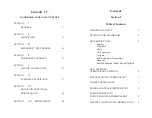
Yak 18T Flight Operations Manual
Page 37 of 82
Disclaimer: This manual is to be used as a reference only, it is based on translated Yak 18T Flight Operations
Manuals and has not been approved by the Yakovlev Design Bureau or any other authority.
this position until the aircraft rotates naturally upon the increase in airspeed.
NOTE:
DO NOT
raise the nose wheel too high. The aircraft typically
ROTATES
as follows –
•
with take-off weight 1,650kg IAS of
135km/h
•
with take-off weight 1,500kg IAS of
125km/h
•
what have you calculated it to be, given your load?
•
After rotation,
INCREASE
IAS to
160-170km/h
for a gradual climb.
NOTE
: just
after rotation, with the airspeed rising, the aircraft tends to quickly increase the pitch-
up angle, be ready to
COMPENSATE
for this with the trim
•
You may have been trained to take-off in a different way, i.e. as above, but upon
rotation, level the nose to the horizon at about 30ft, with the undercarriage still
down, so as to gain the maximum amount of airspeed without climbing and then to
perform the climb out upon sufficient IAS. If you
HAVE
been trained in this way
then fine, if not, continue with the gradual climb approach. Do not attempt this
approach
UNTIL
you have received
SUFFICIENT TYPE TRAINING
. Also be aware
that this approach may infringe your local circuit procedures so
CHECK
first
•
At an altitude of at least
10m (~35ft)
RETRACT
the undercarriage. To do this,
perform the following procedure –
•
MOVE
the undercarriage lever to the
RETRACT/UP
position, take care
NOT
to
retard the lever to the
NEUTRAL
position
•
CHECK
that the undercarriage has
RETRACTED
by noting the illumination of
the
RED
indicator lights on the undercarriage display panel
•
CHECK
that the undercarriage has
RETRACTED
by noting that the port wing,
cowling and starboard wing undercarriage indicator
SIGNALS
have lowered into
the airframe
•
once
SATISFIED
that the lights and indicators are correct and that the
undercarriage has been retracted,
SET
the undercarriage lever to the
NEUTRAL
position
By the time the undercarriage has been retracted and an altitude of ~300ft has been
achieved,
ALTER
the engine conditions from the take-off regime to the
Nominal I
regime
for the climb to circuit height –
•
ACHIEVE
a crankshaft rotational speed of
82%-84%
by first reducing the propeller
pitch and then by reducing the throttle to achieve the desired rpm. This action is to
be carried out swiftly
The climb is to be performed –
•
at IAS of
170km/h
at ambient temperatures up to
+20°C
•
at IAS of
180km/h
at ambient temperatures over
+20°C
•
carry out the usual
500ft CHECKS
CAUTION
•
CONTINUOUS
engine running in the take-off regime is
NOT
to exceed
5 minutes
7.3. Cross-Wind Take-Off
•
The peculiar feature of this take-off is the necessity to
DEFLECT
the yoke into
WIND
from the very beginning of the take-off run
Содержание 18T
Страница 1: ......
















































